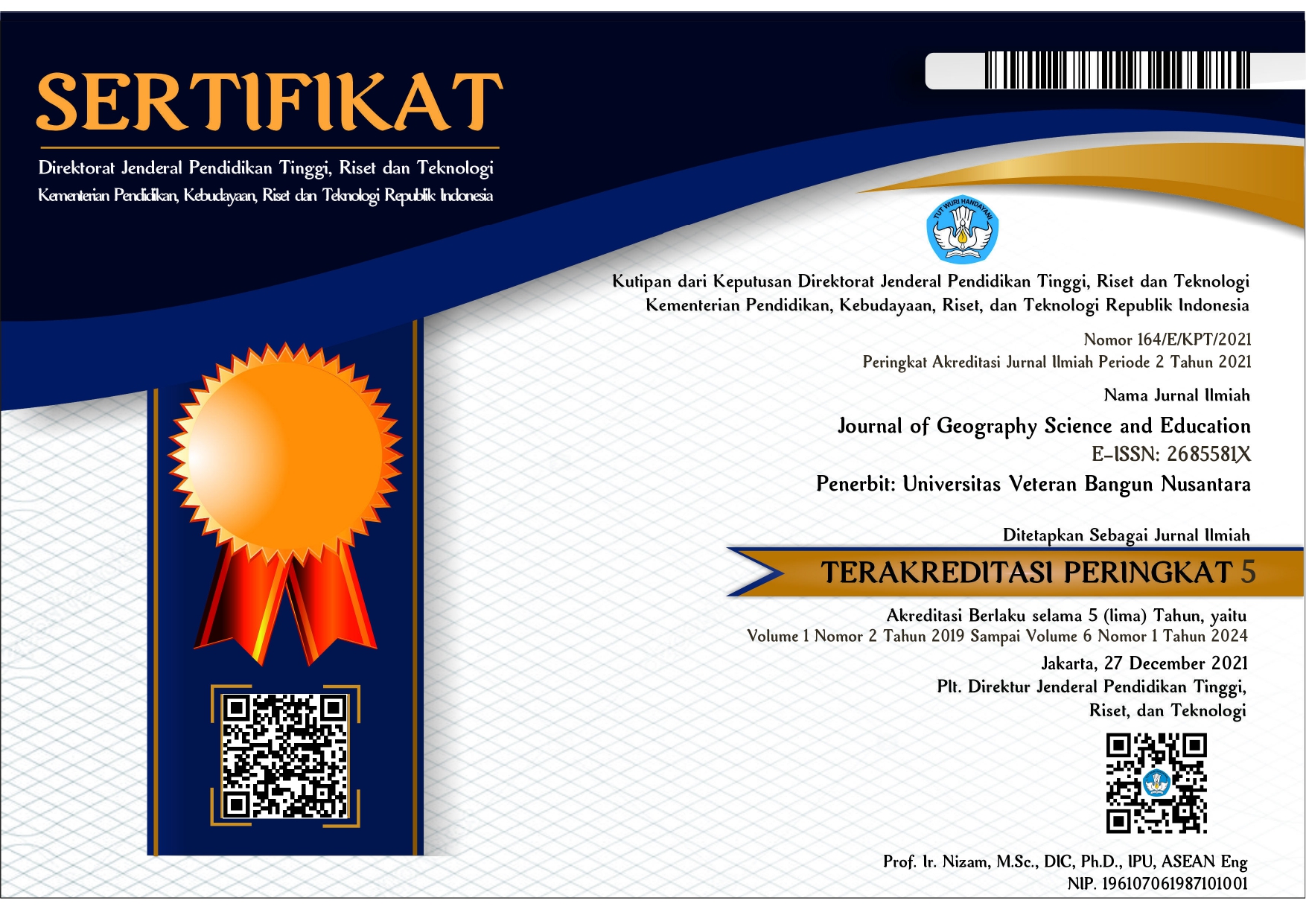UTILIZATION OF LAND IN THE RIVER BORDER AREA IN GROGOL SUB-DISTRICT SUKOHARJO DISTRICT IN 2018
DOI:
https://doi.org/10.32585/jgse.v2i2.1352Keywords:
River Border, Land Use, Image InterpretationAbstract
Utilization of land in the river border area in Grogol Sub-District, Sukoharjo District in 2018. The purpose of this research is to : (1) Knowing the Land Use of River Border Areas in Grogol sub-district; (2) Knowing the types and characteristics of buildings that dominate in the River Border Area, Grogol Sub-District in 2018; (3) Knowing the Suitability of River Border Area Land Use in Grogol Sub-District in 2018 with River Border Regulations. This research uses google earth remote sensing image interpretation method with Quickbird satellite imagery, which describes and knows land use, types and characteristics of buildings and the suitability of land use with boundary regulations. The data collection technique used is through interpretation of satellite imagery, direct field observation. The data analysis technique used was data reduction, data presentation, drawing conclusions / verification. The results of this study are : (1) Utilization of land in the river border area in Grogol Sub-District, Sukoharjo District in 2018, that is Bengawan Solo and Kali Samin rivers consisting of 5 land uses, that is Rice Fields, Garden, House, Empty land, and Factory. (2) The type of land use for house buildings with the characteristics of permanent buildings is more dominant. (3) Most of the land use is in accordance with the Regulation of the Minister of Public Works and Housing Number 28 / PRT / M / 2015, because the use of building land in the river border area in Grogol Sub-District is only about 25 percent or about 42 hectares of the 168 hectares of the river border area in Grogol Sub-District in 2018.
Downloads
References
Eichholtz, P., & Lindenthal, T. (2014). Demographics, human capital, and the demand for housing. Journal of housing economics, 26, 19-32.
Fadhilah Afrizal, 2013, Pemanfaatan Citra Quickbird Untuk Evaluasi Kesesuaian Antara Lokasi Industri Dengan Rencana Tata Ruang Wilayah Tegallega, Universitas Pendidikan Indonesia
Nones, M. (2020). Remote sensing and GIS techniques to monitor morphological changes along the middle-lower Vistula river, Poland. International Journal of River Basin Management, 1-13.
Peraturan Pemerintah Republik Indonesia Nomor 38 Tahun 2011 Tentang Sungsi
Peraturan Menteri Pekerjaan Umum Dan Perumahan Rakyat Nomor 28/PRT/M/2015 Tentang Penetapan Garis Sempadan Sungai Dan Garis Sempadan Danau
Rezki Afrital Rezki, 2014, Penerapan Metode Penginderaan Jauh Dan Sistem Informasi Geografis Untuk Analisa Perubahan Penguunaan Lahan (Studi Kasus: Kawasan Danau Maninjau), Program Studi Pendidikan Geografi, STKIP PGRI Sumatera Barat
Setyadi Anton, (2013) Analisis Keselarasan Letak Bangunan Dan Pemanfaatan Lahan Terhadap Peraturan Sempadan Sungai Menggunakan Citra Satelit Quickbird (kasus sepanjang sungai code, Kota Yogyakarta), Universitas Muhammadiyah Surakarta, Fakultas Geografi
Sunarhadi M A, Suharjo , Anna A. N , Anwar B. S (2015) Penentuan Lebar Sempadan Sebagai Kawasan Lindung Sungai di Kabupaten Sukoharjo , Universitas Muhammadiyah Surakarta.
Sutanto, 1998. Penginderaan Jauh Jilid I. Yogyakarta ; Fakultas Geografi. Universitas Gadjah Mada. Gadjah Mada University Press.
Wiweka, (2013) Standardisasi Klasifikasi dan Simbol Lahan Perkotaan Diturunkan dari Citra Resolusi Spasial Tinggi, Pusat Pemanfaatan Penginderaan Jauh Lembaga Penerbangan dan Antariksa Nasional
Downloads
Published
How to Cite
Issue
Section
License
Authors who publish with the Journal of Geography Science and Education agree to the following terms:
- Authors retain copyright and grant the journal the right of first publication with the work simultaneously licensed under a Creative Commons Attribution License (CC BY-SA 4.0) that allows others to share the work with an acknowledgment of the work's authorship and initial publication in this journal.
- Authors are able to enter into separate, additional contractual arrangements for the non-exclusive distribution of the journal's published version of the work (e.g., post it to an institutional repository or publish it in a book), with an acknowledgment of its initial publication in this journal.
- Authors are permitted and encouraged to post their work online (e.g., in institutional repositories or on their website) prior to and during the submission process, as it can lead to productive exchanges, as well as earlier and greater citation of published work.










